An Italian American’s perspective on this iconic Italian dish. Its journey through time maps both the hyper-regionality of Italian cuisine and the migrations of the Italian diaspora.
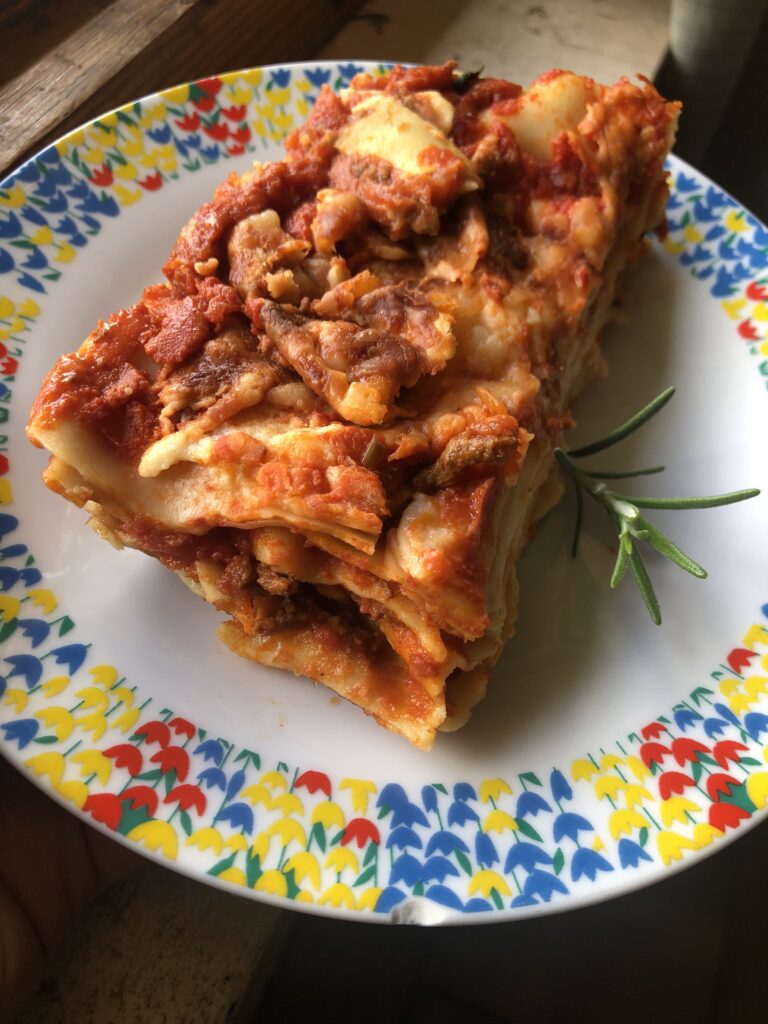
What makes it Lasagna?
You might think you already know the answer, yet you might be surprised! When you look at different Lasagna recipes, certain questions arise, like:
What is the original recipe or traditional way to prepare it?
How do you spell it anyway, Lasagna or Lasagne?
Are egg noodles traditional? Is it made with ricotta, mozzarella, or bechamel? Red sauce or Pesto? Should you cook the noodles first or let them cook in the sauce? Does the sauce have meat, or is it vegetarian?
We’ll answer all these questions and more in this brief history of Lasagna and how it created a legacy.
Lasagna History
The word Lasagna comes from the Greek word Laganon. It describes the first known form of pasta, appearing on ancient Greek tables between 1000-800 BCE. Some historians argue that Greece is the birthplace of pasta.
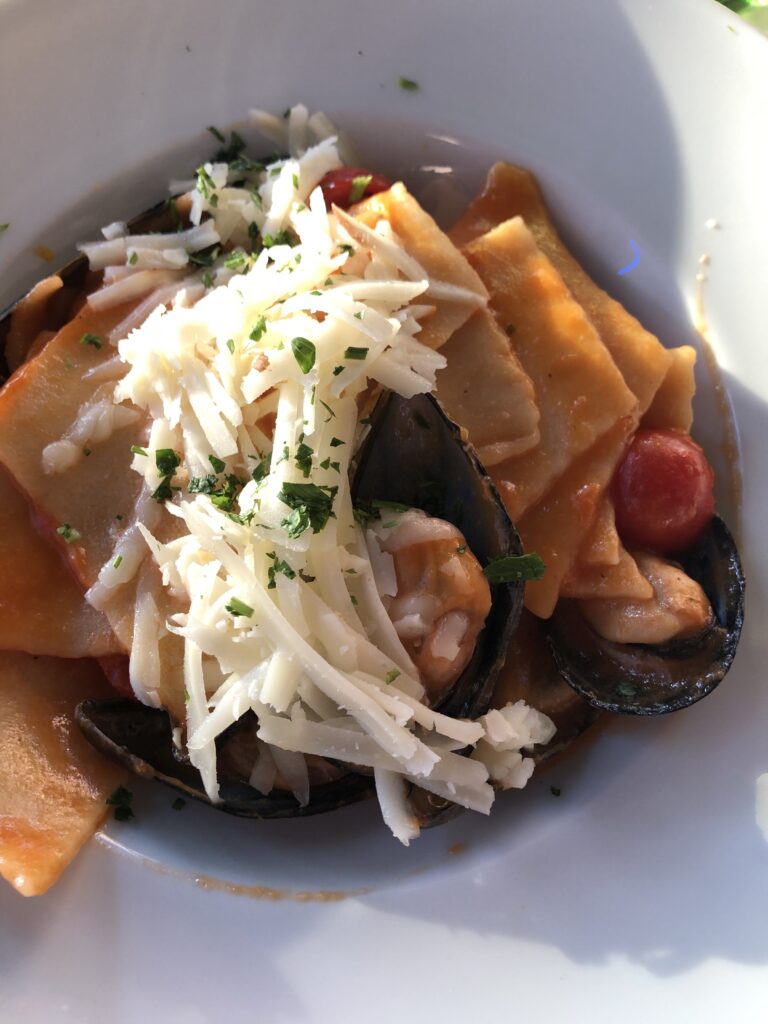
The Original Pasta Shape
Laganon is described in ancient texts in both Greek and Latin as a sourdough containing olive oil and flour. To prepare the dough, it was rolled flat, possibly cut into irregular shapes, and layered with sauce. These sheets could have been boiled, fried, or fire-cooked; the sources and opinions vary.
However, the shape of Laganon was probably similar to maltagliati, an egg noodle shape still served today in Italy, mainly in Emilia-Romagna. It means “badly cut” for its rustic shape.
The Sauce
However, the sauce would not have been from tomatoes because those are native to the Americas. They didn’t hit Italian plates until the year 1550. However, Italians are credited with being the first Europeans to embrace this new produce.
So what kind of sauce did the ancients use?
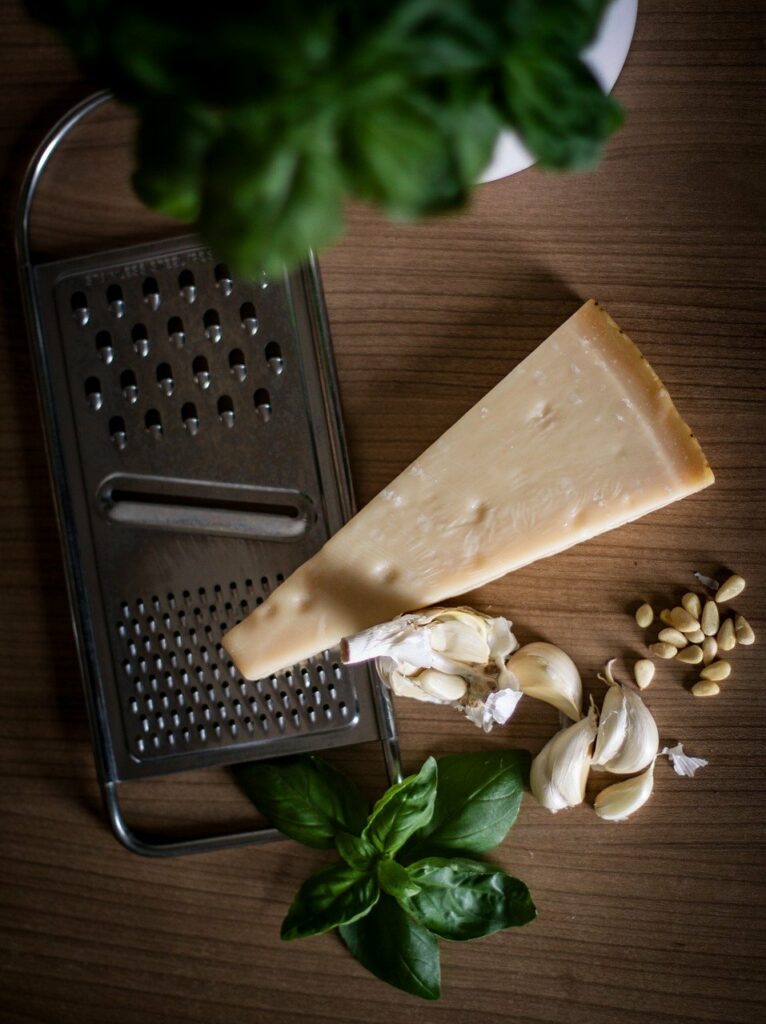
The most recognizable sauce to us today would be Pesto–a flavorful sauce containing herbs, garlic, nuts, and cheese. Strictly speaking, Pesto is a generic term for anything made by pounding. In fact, its name comes from the pestle, a tool used in the kitchen to crush ingredients together to create a paste.
Pesto recipes go back to Roman times. They used to eat a similar paste called moretum. The recipe for moretum is to crush garlic, salt, cheese, herbs, olive oil, vinegar, and maybe pine nuts together to create a spread for bread. Perhaps they could have used it in Laganon, but we have no documentation to suggest it.
Humble Beginnings
Horace, a Roman poet, describes Laganae, the plural of Laganon, or in Latin, laganum, meaning wafer.
In one of his collections of poems called Satires, he writes that he cannot wait to get home to enjoy a bowl of leeks, chickpeas, and laganum. This daily Roman fare, was eaten by most of the common people in his day. It seems like things haven’t changed much. Pasta is still a staple food in Italy today.
Here is a Calabrese recipe for Lagana e Ceci (Lagana pasta with chickpeas)
First Lasagna Recipes
How did Lasagna evolve from its humble origins to become the hearty and rather extravagant dish we know today? If you read my Guide to Carnevale you know that in some Italian regions, especially in Naples, Lasagna was considered a delicacy. It was only eaten during the “crazy days” before lent, a time to use up all your meat and dairy products before the restrictive fasting began. To Neapolitans, Lasagna was a once-a-year indulgence.
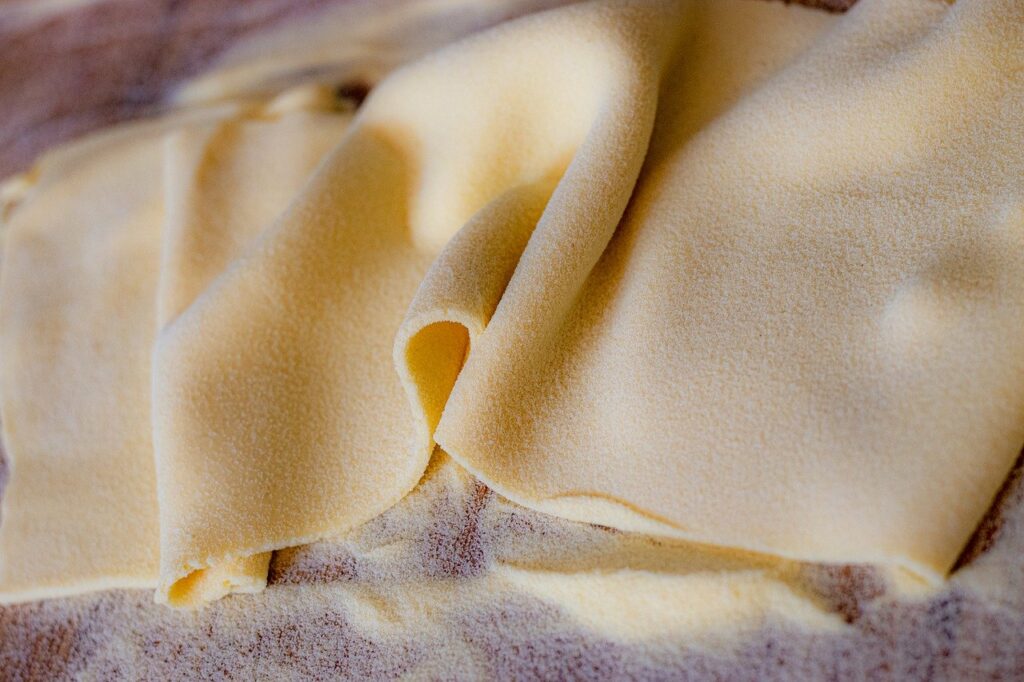
To get a more precise answer on its transformation from peasant food to richer fare we head to the year 1282.
The oldest transcribed text about Lasagne appears in the Memoriali Bolognesi, in which Lasagne is mentioned in a poem transcribed by a Bolognese notary in that year.
The first actual recorded recipes for Lasagna didn’t appear until the early 14th century. The first is in Liber de Coquina. The author of this Book of Cookery is unknown but believed to be from Naples. This recipe only slightly resembles Lasagna as we have come to know it. Like the Greek Laganon dough, it was flattened, boiled, then sprinkled with cheese and spices.
Lasagna Evolution
Recipes written in the century following the Liber de Coquina suggest to boil the pasta in chicken broth and mix it with cheese and chicken fat. Some recipes were specific to the Lenten fast and replaced the animal products with crushed walnuts instead.
The second 14th-century source is a historic recipe that most closely resembles modern-day Lasagna. It comes from a British cookbook, called the Forme of Cury which was published in the 1390s at the behest of King Richard II. The recipe is for loseyns, which some linguists say probably pronounced “lasans.” Therefore, some British historians claim that Lasagne originated in England. This declaration was, of course, staunchly denied by a representative for the Italian embassy in London.
However, no matter where Lasagne originated, I think we can all agree that Italians perfected it.
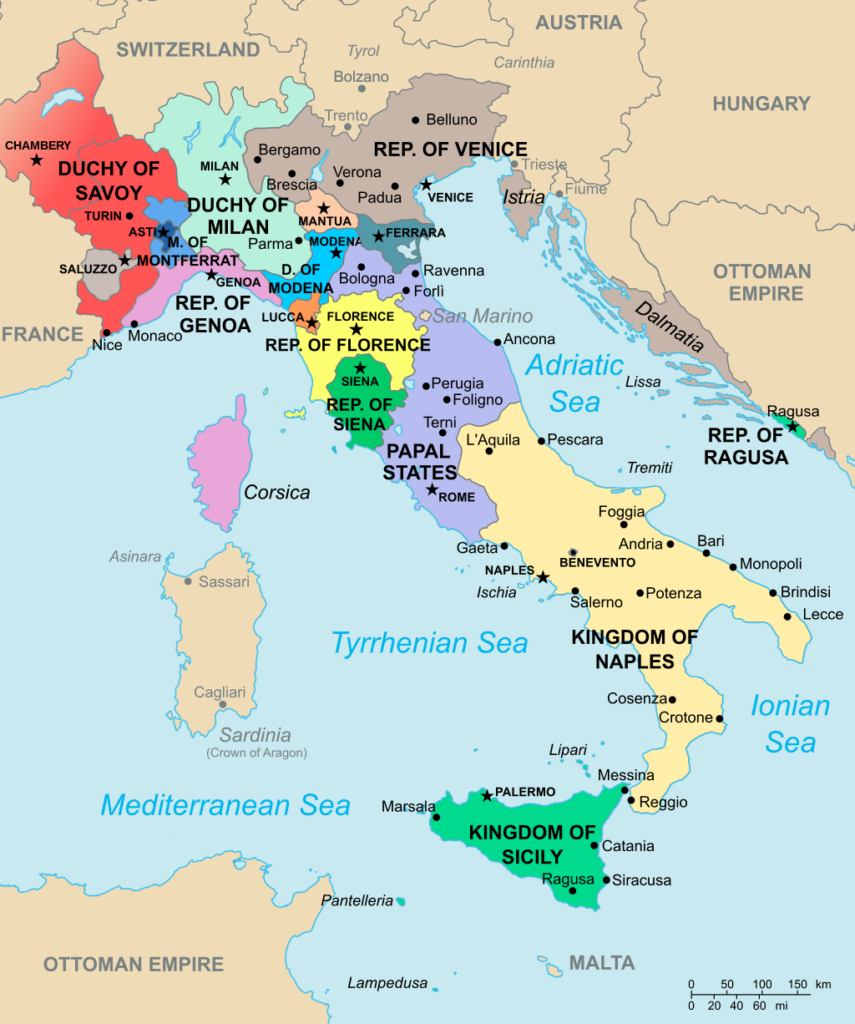
By User:Shadowxfox; User:Enok – Derivative works of this file: Italy 1494 de.svg:, CC BY-SA 3.0, https://commons.wikimedia.org/w/index.php?curid=20332552
But which Italians?
Italy, as a country, was not completely unified until 1870. Previously, it comprised eight different states, many of these consolidated into major political units that balanced the power on the Italian peninsula. These states had their own laws, culture and languages or dialects. Even today, there are about 20 different ones spoken. The linguist Max Weinreich says that “a language is a dialect with an army and a navy.” If you want to read more about the difference between a language and a dialect (there really isn’t one!), this article is an excellent place to start.
Lasagna is Regional
The most common version of the dish, which most people know, comes from a recipe that originated in the Emilia-Romagna region of Italy during the 19th century. Known as Lasagne alla Bolognese in many places, it consists of layers of thin pasta dough made with flour, egg, and spinach. Yes, the noodles are green.
Ragù, a thick meat sauce, and béchamel, a white sauce made with a base of butter, flour, and milk, spiced with nutmeg, are spread between each layer. Parmigiano-Reggiano cheese is lightly sprinkled on the top layer to melt, making it crispy on top.
Lasagne al Forno or baked Lasagna is almost identical to the Bolognese version, but the egg pasta dough does not contain spinach. This version is the basic recipe that most other Lasagna recipes are based on.
The lasagna of Naples, lasagne di carnevale is also traditional, in that region. As mentioned, it is a much heartier version and is made with local sausage, fried meatballs, hard-boiled eggs, ricotta, or mozzarella and layered with ragù. Naples is also credited with using the first tomato-based sauce, which appeared in the 1880s.
Lasagne alla Portofino from the Liguria region of Italy consists of egg noodles layered with basil pesto and bechamel. Then it’s topped with Parmigiano and sometimes extra pine nuts. Before they invented basil pesto in the 1800s, the Genovese ate their lasagne pasta either cooked in broth and sprinkled with cheese or seasoned with condiments such as prescinsêua cheese (a cross between yogurt and ricotta), typical ricotta and cinnamon, or sauces of mushrooms and hazelnuts.
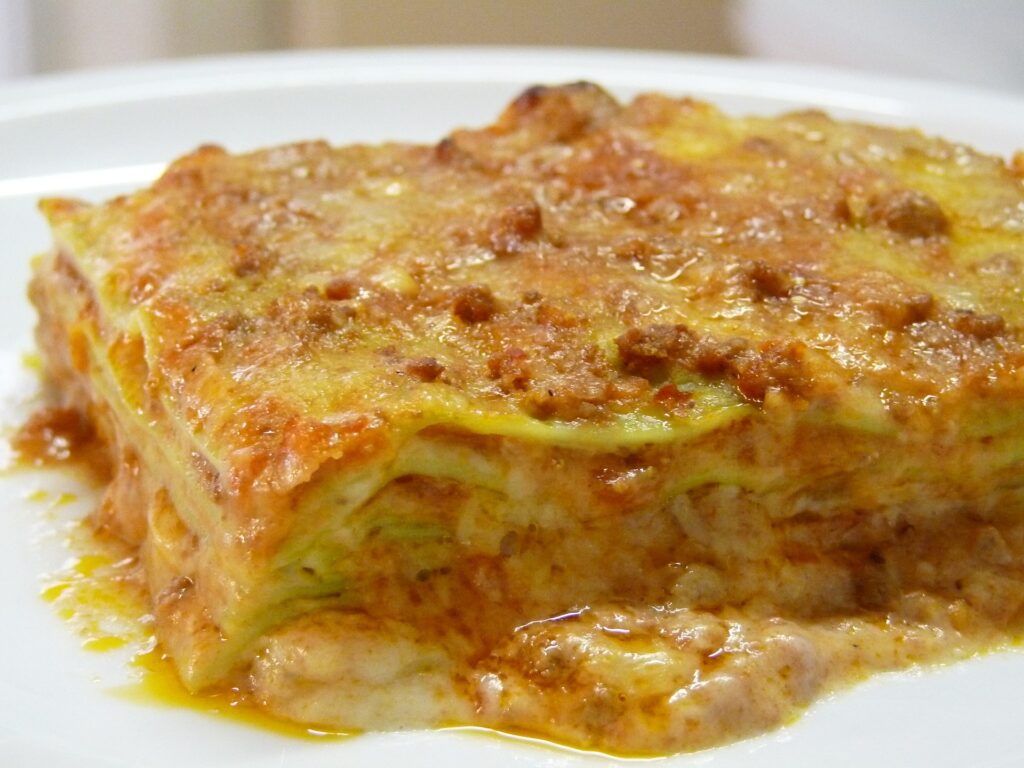
The Accademia Italiana di Cucina (Italian Kitchen Academy) has the final word on which is the “official” recipe. After careful analysis, they registered what they call the original and traditional “Lasagna” recipe at the Chamber of Commerce in Bologna. That’s right, the most traditional version of Lasagna has green noodles!
Click here to make your own pasta verde lasagna noodles!
OK, But What is the Difference Between Lasagna and Lasagne?
Some people spell it Lasagna while others use Lasagne. Both terms, by the way, are pronounced exactly the same in English, and are perfectly acceptable. However, besides different spellings, the words also have a slightly different meanings in modern Italian. Lasagna refers to a single noodle, whereas Lasagne is the plural.
To put that into perspective, most pasta shapes are referred to in the plural – rigatoni, spaghetti, farfalle, and penne, are all plural. It makes sense because you have a box or bag full of them.
In Italian, the dish in all its various forms and interpretations is spelled Lasagne. The British spell it Lasagne, too, in reference to all the noodles it takes to make the dish.
Lasagna, the way most Americans spell it, refers to the dish in its entirety, a singular item. Like Pasta al Forno – or baked pasta, pasta is the singular noodle while paste is the plural.
Lasagna is a Legacy

As we can see, Lasagna or Lasagne means many things to different people. It’s not such a strange notion when you follow Lasagna’s history and travels.
Lasagna has a legacy that starts with love that stands the test of time, the passion embedded in our hearts.
Lasagna is THE dish that my husband asks for on his birthday every year. My kids know that when Babbo’s birthday comes around, Lasagna will be on the table. It’s a family tradition.
Although I’ve lovingly made it for my husband for about 15 years, every time I make it, he tells me it is the best one ever. That’s because my own recipe has changed significantly over the years. Its metamorphosis is colored by my Italian American heritage, my travels through Italy, and my experiences living in Sardinia for several years now. As an anthropologist who appreciates food, it isn’t hard to see that this journey reflects the story of Lasagna itself.
Let me explain…
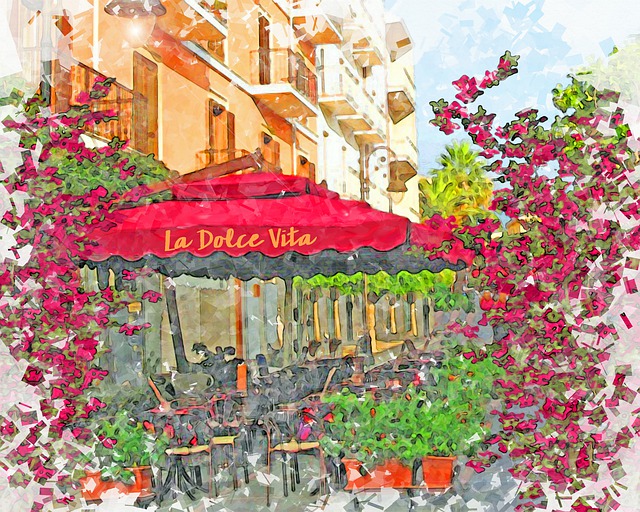
Lasagna is personal. Although it has only been known throughout Italy for a short time during its long history, it is a nostalgic dish, even for Italians. Like its Pasta al Forno cousins, it gathers us to the table. Lasagna brings a commonality to the tables across Italy as Nonne and Mamme prepare this favored dish for Sunday lunch. Much like the Italian language allowed the people of this peninsula and the islands to come together in a common language not that long ago, Lasagna also brings people together. As you start to imagine the Sunday lunch scene, observe how the recipes change, taking on regional color, and, as much of Italian cuisine, reflecting what is in season.
Even on Giallo Zafferano, the largest Italian language recipe site, you will find highly voted recipes for Lasagne featuring seafood, rabbit, lamb, artichokes, squash, and even one made with pistachios. This is in Italy! A country dedicated to its food traditions, with many food rules. Yet each region and each family can make this dish, bound by noodles, sauce, and cheese their own.

Italian Diaspora
Now once we leave those azure Mediterranean shores and follow our Ancestors to other lands, imagine how their coveted, traditional dishes might need to change in order to adapt to the available and seasonal ingredients in their new homes.
If you’ve ever traveled and missed the foods of home, you’ll understand our Ancestors’ need to adapt their food traditions. It isn’t some giant conspiracy to poke fun at or dishonor food traditions by deliberately creating something ridiculously inauthentic. It is about comfort and memories of home. It traces a journey of hope and love so as not to forget where you come from while adapting to a new home. Just ask any immigrant; food is a legacy.
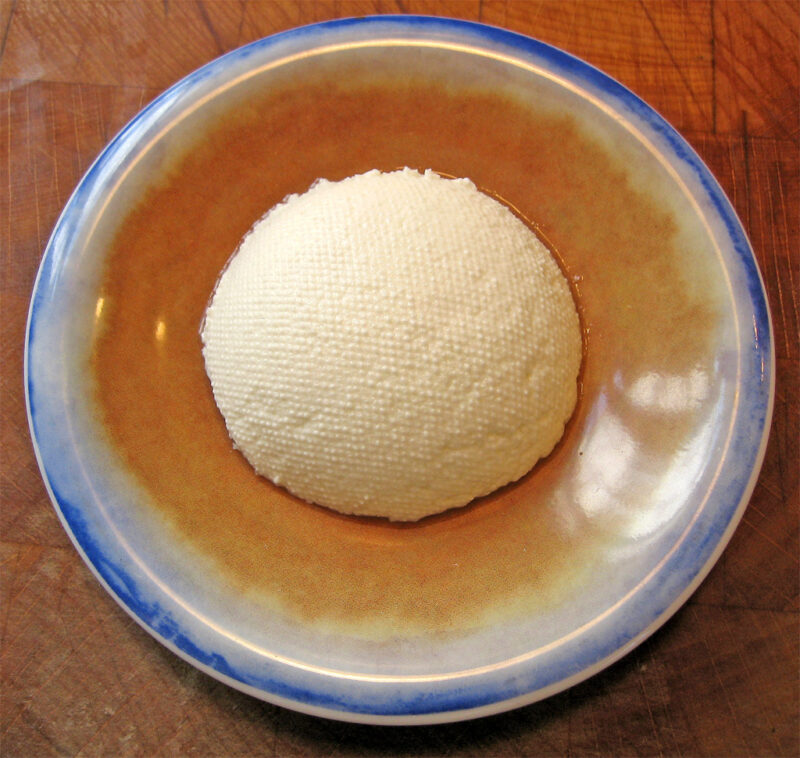
Ricotta Ridicule
I see it all the time, people ridiculing the inclusion of ricotta in lasagna recipes. It is described as an “American thing” that no self-respecting Italian would eat. However, as we’ve learned, ricotta is actually a traditional ingredient in Neapolitan Lasagna, one of the founding historic recipes to influence modern-day Lasagna.
The first Lasagna recipe that I used in my 20s and early 30s included ricotta and spinach. But the spinach wasn’t in the noodles; instead, I layered it between noodles, cheese, and sauce.
Although I was wrong about how to use the spinach, I wasn’t wrong about including it in the dish. Just ask the Accademia Italiana di Cucina. However, many “experts” of Italian food will laugh you out of the kitchen when you mention spinach lasagna.
When I met my Italian-born husband and started talking about food, as most Italians do, I was surprised that he wasn’t familiar with all the dishes I grew up with. For example, when my mom and I made pizzelles at Christmas, he had never tasted them before.
I sometimes wondered if he was really Italian at all. At that time, I had not yet been to Italy, and I wasn’t aware that in Italy, dishes are hyper-regional. I was only familiar with Italian-American dishes, which have their own rich and well-deserved history and some special recipes from Sicily. I have never had lasagna in Sicily, but I hear it is made with peas and chopped hard-boiled eggs.
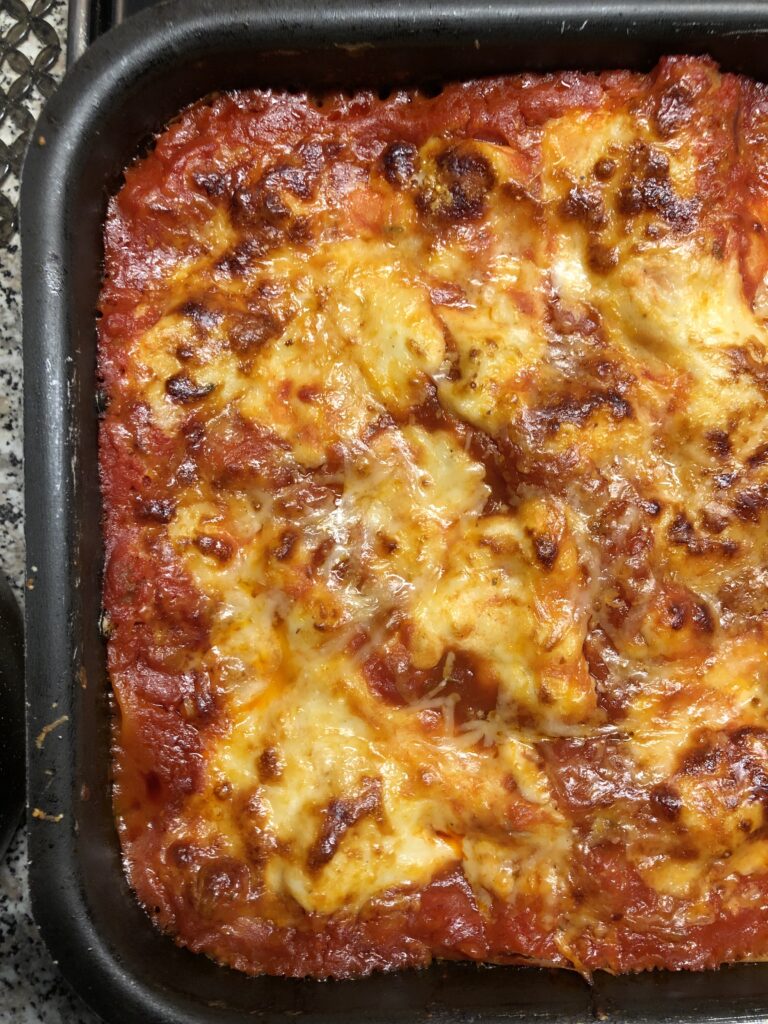
The Importance of Diasporic Cooking
Genius is often born from necessity. So, when people emigrated from Italy to the United States in droves during the late 19th and early 20th centuries, they had to adapt dishes from their hometowns based on what was available to them once they crossed the ocean.
In my work, I like to focus on building bridges. I look at various subjects, especially conflict areas, and highlight where they cross over and come together. Therefore, I am particularly fascinated and inspired by diasporic cooking (yes, I am pretty sure I made this term up, but I think it really works).
Diasporic cooking is different than fusion cuisine. Fusion cuisine combines elements of various culinary traditions that originate from different countries, regions, or cultures in the attempt to create something unique.
On the other hand, Diasporic cooking is the natural evolution of traditional dishes from a culture or region as they adapt to ingredients available in a new country. Unlike fusion cuisine, it is not attempting to invent something new. Rather it comes from the desire to preserve it as a relic from home.
Of course, the people we meet in life can also change our habits and opinions. Italian immigrants from various regions came together over their new tables, and as people do, especially Italians, they talked about food and shared recipes.
Imagine a story where an immigrant from Naples shared the lasagne recipe they prepared for their child’s wedding with their guest who loved it, a dear friend from Tuscany. The Tuscan had never heard of Lasagne, so they made it according to the recipe and shared it with their descendants. This recipe became the Tuscan family’s Lasagna Legacy, born from love and the desire to share it with others.
Traditions are alive and, by their very nature, changing. Food is tradition.

My Lasagna Legacy
My mom passed away in March, and I have been thinking about her legacy and everything she taught me. Lasagna is a beautiful symbol of what it means to be Italian, whether you were born and raised in Italy or your ancestors left their Mediterranean homes for distant shores. We carry this legacy of love in our blood.
Thinking about my mom, it’s impossible not to think about Italian culture and food. She was proud of her Mediterranean roots. Her father was born in a small village called Alia outside Palermo, and her maternal grandparents were from Cosenza, in Calabria.
Many of the most common and often the best memories I have of my mom revolve around the kitchen. Our favorite activities were cooking (and eating!) and traveling, especially to Italy, which we got to do together three times. I vividly remember cooking and photo shooting my first lasagna version in my mom’s kitchen for my very first blog, The Leftover Queen, in 2007, the one that included ricotta and spinach.

To honor her legacy, which is another cornerstone of all the work I do – legacy building, I am compelled to focus on Italian food history and culture during the next few beats. As always, it will be through the lens of animism, the old ways, and ancestral practices, which are how I filter information.
(If you’re interested in seeing what that focus looks like, I invite you to read my 3-part series on the Mediterranean Diet, Blues Zones, Italian Food culture & history).
Our life experiences dictate food choices and preparations. Excavating the history of food, regional cuisine, and especially immigrant cuisine tells us so much about the lands people came from and the places they live now. Every ingredient tells a story about the environment, geography, and climate it comes from.
In order to pass on that love, I am sharing TWO of my Lasagna recipes with you. One reflects my Italian-American upbringing and the other my experiences in living in Sardinia.

What’s Next?
In the not-too-distant future, these kinds of mega- articles will be available through my newsletter. The blog will feature excerpts of those articles. Make sure you don’t miss the full articles by signing up, here. It’s free!
I’m also going to keep talking about the ancestral practice of food preparation, using that sacred key for unlocking the unique wisdom embedded in each of our DNA. That wisdom comes to the surface when we prepare food. This expression of my current line of thought will cumulate in a book, Pasta in Every Season (90+ Pasta recipes, plus 15 recipes for bread, antipasti, sides & dessert to round out your meal).
The book is 80% finished. It will be released in a way that will introduce the new modalities in which I will be sharing my work with all of you in the future.
Also on deck is my book Witches’ Brews: Tea, Broth & Sauce (all year round!)
+
Old Ways for Modern Families. The first module focuses on using food as a key to unlock the Ancestral wisdom entwined in our DNA.
Click here to join the waiting list! There is a limit of 12 seats! Waiting list members get first dibs on signing up and access to the Early Bird special I will run.
Two Lasagna Recipes for You!
Most Lasagna in Italy is made with a bechamel sauce instead of ricotta cheese. However, in the city of Naples, ricotta lasagna made with fresh egg noodles was traditionally served during Carnevale and only in tiny portions due to the expense of making it.
When Italian immigrants from that city came to the United States in the early 1900s, they learned that meat in their new country was cheaper than it was at home. So, Lasagna became more everyday fare, especially when they opened restaurants and put it on the menu for their American customers.

Here is my Italian-American Lasagna recipe to honor our Ancestors who crossed oceans hoping for a better life for their descendants.
The second recipe, Sardinian 3-Cheese Lasagana, I will share with my newsletter subscribers. Sign up here!
INGREDIENTS:
2 tablespoons olive oil
1 pound sweet Italian sausage
1 pound lean ground beef
1 large white onion, minced
5 cloves garlic, minced
2 tablespoons sugar
½ cup chopped fresh basil
1 teaspoon ground oregano
½ teaspoon sea salt
¼ teaspoon ground black pepper
¼ cup + 2 tablespoons chopped fresh parsley (divided)
2 (28-ounce can) crushed tomatoes
2 (6-ounce can) tomato paste
1 cup water
1 pound dried no-boil lasagna noodles
30 ounces ricotta cheese, strained
2 large eggs
½ teaspoon salt
⅛ teaspoon ground nutmeg
1 pound sliced mozzarella cheese
2 cups of fresh spinach
1 cup freshly grated Parmigiano-Reggiano
METHOD:
Heat the olive oil in a large pot over medium heat, then add the ground meats. Use a spoon to break up the meat into small pieces as it browns.
Add the onion and garlic and cook until meat is well browned, stirring constantly. Stir in sugar, fresh basil, oregano, about ½ teaspoon salt, pepper, and ¼ cup of the chopped parsley. Mix well. Then add the crushed tomatoes, tomato paste, and water. Stir well and bring to a simmer. Reduce heat to low and simmer for half an hour, stirring occasionally. This is less time than typical because you are using no-boil lasagna noodles. This requires the sauce to be looser than normal.
In a mixing bowl, combine ricotta cheese with the eggs, remaining 2 tablespoons parsley, ½ teaspoon salt, and nutmeg. Preheat the oven to 375 degrees. Lightly grease a deep 9×13 pan.
To assemble, spread about 1 cup of meat sauce in the bottom of the prepared pan. Place a layer of noodles on top. Spread with ⅓ of the ricotta cheese mixture. Top with ¼ of mozzarella cheese slices. Spoon 1½ cups meat sauce over mozzarella, then layer in ¼ of the spinach. Finally, sprinkle with ¼ cup parmesan cheese. Make sure to cover the noodles with the sauce and cheese completely.
Repeat layering two more times to create three complete layers. To finish, place a final layer of pasta, topped with another 1 cup of meat sauce to cover the pasta. Top with remaining mozzarella and Parmesan cheese.
Bake in preheated oven for 40-45 minutes. Allow cheese to brown and the sides to be bubbling. When it is finished, take it out of the oven, and allow it to sit for 15 minutes before slicing and serving. Serves 8-10
Buon Appetito!

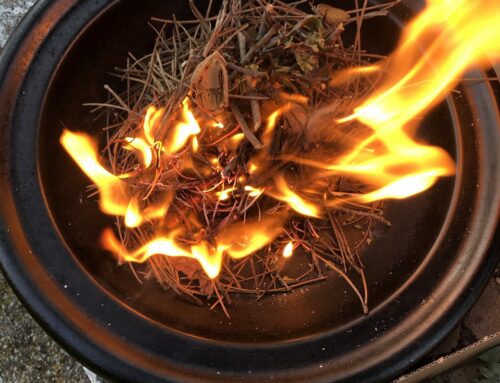
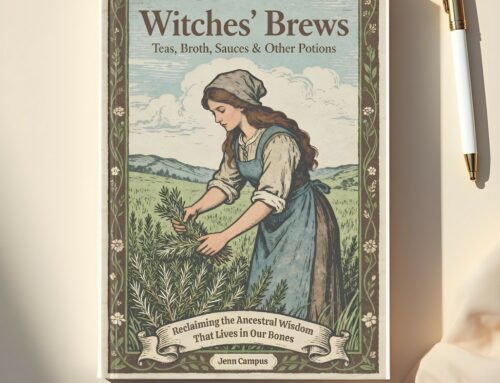



Loved all the information in this! I’ve never really thought about food in this way. Which is funny because I’m all about making everything from scratch and cooking all the time! I guess since I was never given a food legacy, it’s hard for me to imagine how my kitchen work will fit into my legacy that I leave behind.
Hi Katrina,
I’m glad to article gave you some food for thought (sorry, I couldn’t help the pun!). I am sure that your kitchen work will become part of your incredible legacy.